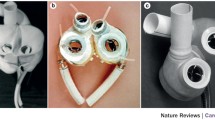Summary
We have developed and tested systems for long-term heart replacement ventricular assistance without percutaneous leads. A rollerscrew energy converter actuates a single sac-type blood pump for ventricular assistance, or alternately ejects the left and right pumps of a total artificial heart. A simple compliance chamber assures modest variation of pressure within the sealed energy converter housing. An implanted canister contains control electronics and a battery capable of providing 30–50 min of operation. Energy is transmitted inductively from a ring-shaped external coil to a mound-shaped subcutaneous coil. Information is transmitted to the implant by frequency modulation of the power carrier and from the implant by radio frequency transmission. External equipment includes a battery pack with simple indicators, a battery charger, and a physician’s office or laboratory monitoring system. Both systems have undergone initial in vivo testing in calves. Eleven total artificial heart recipients survived from 1 to 118 days. The most common complication of the implant procedure was pulmonary dysfunction. The longest-surviving recipient was euthanized for progressing sepsis originating at a percutaneous monitoring line. The first assist system operated for 84 days before failure of the energy transmission secondary coil. The second assist implant is ongoing at 125 days. These studies thus far have demonstrated the implantability of the systems and have verified the proper function of the implanted controller. Experiments will continue in order to determine long-term interactions with the recipient.
Access this chapter
Tax calculation will be finalised at checkout
Purchases are for personal use only
Preview
Unable to display preview. Download preview PDF.
Similar content being viewed by others
References
Rosenberg G, Snyder A, Weiss W, Landis DL, Geselowitz DB, Pierce WS (1982) A rollerscrew drive for implantable blood pumps. Trans Am Soc Artif Intern Organs 28:123
Richenbacher WE, Pae WE, Magovern JA, Rosenberg G, Snyder AJ, Pierce WS (1986) A rollerscrew electric motor ventricular assist device. Trans Am Soc Artif Intern Organs 32:46–38
Snyder AJ, Rosenberg G, Weiss W, Huang W, Landis D, Pierce WS (1984) Chronic animal studies with a motor-driven LVAD and an implanted compliance chamber. Trans Am Soc Artif Intern Organs 30:92–97
Snyder AJ, Weiss WJ, Pierce WS, Nazarian R (1989) Microcomputer control of implantable blood pumps. Proc 2nd Annual IEEE Symp on Computer-Based Medical Systems. IEEE Press, NY, pp 154–157
Weiss WJ, Rosenberg G, Snyder AJ, Pae WE, Richenbacher WE, Pierce WS (1989) In vivo performance of a transcutaneous energy transmission system with the Penn State motor driven ventricular assist device. Trans ASAIO 35(3):285–288
Snyder AJ, Rosenberg G, Pierce WS (1992) Noninvasive control of cardiac output for alternately ejecting dual pusherplate pumps. Artif Organs 16(2): 189–194
Snyder AJ, Pae WE, Rosenberg G, Weiss WJ, Pierce WS (1991) The Penn State implantable artificial heart: Current status. In: Akutsu T, Koyanagi H (eds) Artificial heart 3. Springer, Tokyo, pp 205–213
Schuder JC, Gold JH, Stephenson HE Jr (1971) An inductively coupled RF system for the transmission of 1 kW of power through the skin. IEEE Trans Biomed Engr BME 18(4):265–273
Sherman C, Daly B, Dasse K (1983) Research and development: Systems for transmitting energy through intact skin. Final Technical Report (N01-HV-0–2903–3) for Devices and Technology Branch, Div Heart and Vascular Diseases, National Heart Lung and Blood Institute
Snyder AJ, Rosenberg G, Landis D (1985) Indirect estimation of circulatory pressures for control of an electric motor-driven total artificial heart. In: Langrana NA (ed) 1985 Advances in bioengineering. The American Society of Mechanical Engineers, New York, pp 87–88
Author information
Authors and Affiliations
Editor information
Editors and Affiliations
Rights and permissions
Copyright information
© 1993 Springer Japan
About this chapter
Cite this chapter
Snyder, A.J. et al. (1993). Completely Implantable Total Artificial Heart and Heart Assist Systems: Initial In Vivo Testing. In: Akutsu, T., Koyanagi, H. (eds) Heart Replacement. Springer, Tokyo. https://doi.org/10.1007/978-4-431-67023-0_15
Download citation
DOI: https://doi.org/10.1007/978-4-431-67023-0_15
Publisher Name: Springer, Tokyo
Print ISBN: 978-4-431-67025-4
Online ISBN: 978-4-431-67023-0
eBook Packages: Springer Book Archive




